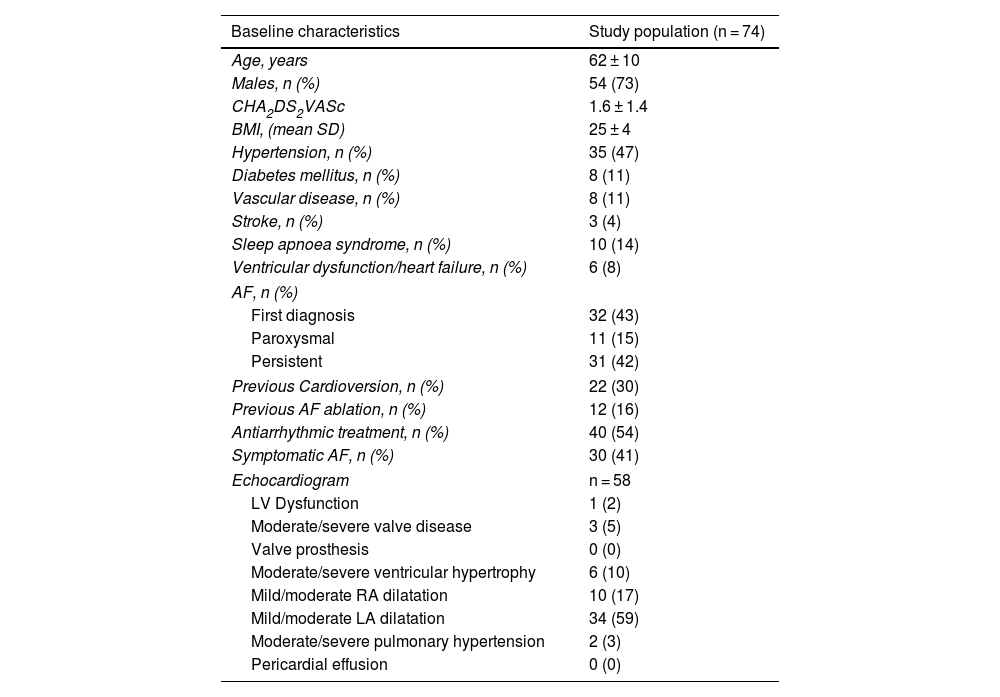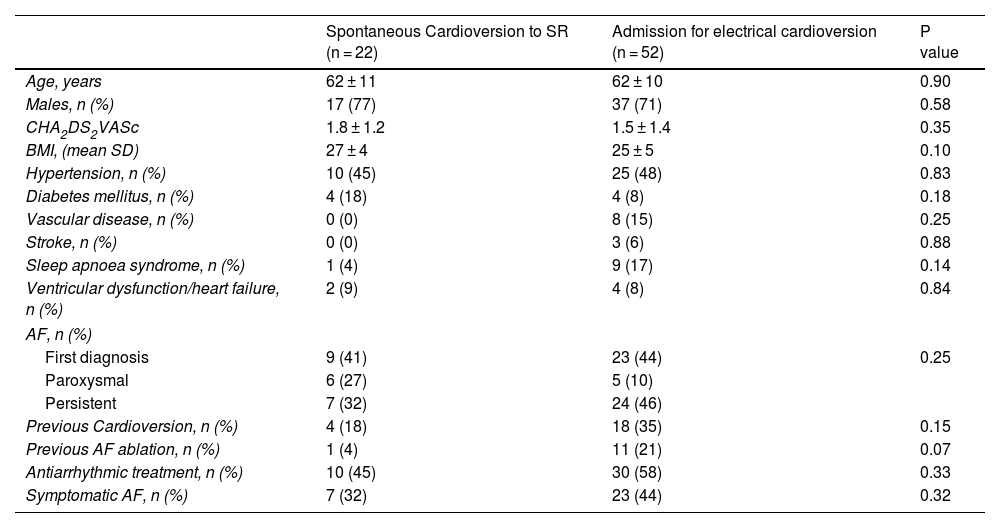Management in recent-onset atrial fibrillation (AF) is to achieve sinus rhythm (SR) by cardioversion (CV). However, frequently SR is spontaneously restored, making scheduled admission unnecessary and causing misutilization of healthcare resources. Emerging medical technology allows accurate heart rhythm monitoring. This study evaluated this technology in these patients, preventing unnecessary admission and providing an earlier management.
MethodsA multicenter study was designed including patients with AF scheduled for elective electrical CV. Patients submitted ECG recordings to a central Corelab daily, twice a day and whenever they present symptoms, until CV (spontaneous or scheduled) and a week afterwards. Whenever a spontaneous conversion to SR was detected, investigators were contacted to confirm SR and abort admission. Patients’ satisfaction was evaluated using a test for perceived utility, convenience, and accessibility.
Results74 patients were enrolled (age 62 ± 10 years). Twenty-two patients (30%) showed spontaneous conversion to SR. A total of 22 admissions and 16 transesophageal echocardiograms were prevented. Among 52 patients admitted for CV, 45 (88%) were discharged in SR. During follow-up after conversion to SR (spontaneous or electrical), recurrences of AF occurred in 24 patients (34%). At the end of the follow-up 51 patients (69%) remained in SR. The CoreLab received 93% of the expected ECG transmissions. Patient’s overall satisfaction score was 9.1 over 10.
ConclusionDigital devices for heart rhythm monitoring can optimise the management of AF patients scheduled for elective CV, preventing unnecessary admissions and providing a more rational use of healthcare resources.
Habitualmente el abordaje de la fibrilación auricular (FA) persigue restaurar el ritmo sinusal (RS) mediante la cardioversión (CV) ambulatoria. Sin embargo, frecuentemente el RS se restablece espontáneamente, lo que puede ocasionar una mala utilización de recursos sanitarios. La tecnología médica emergente permite una monitorización precisa del ritmo cardíaco. Este estudio pretende evaluar el papel de esta tecnología en estos pacientes, evitando ingresos innecesarios y proporcionando un abordaje precoz.
MétodosSe diseñó un estudio multicéntrico incluyendo pacientes con FA programados para CV eléctrica ambulatoria en 7 centros. Los pacientes enviaron registros ECG diariamente, hasta la CV (espontánea o programada) y una semana después. Ante una CV espontánea, se contactaba con los investigadores para confirmar el RS y abortar el ingreso. La satisfacción de los pacientes se evaluó mediante un cuestionario.
ResultadosSe incluyeron 74 pacientes (62 ± 10 años). Veintidós pacientes (30%) presentaron CV espontánea. Se evitaron 22 ingresos y 16 ecocardiogramas transesofágicos. De 52 pacientes ingresados para CV eléctrica, 45 (88%) fueron dados de alta en RS. Durante el seguimiento tras la CV a RS (espontánea o eléctrica), hubo recurrencias de FA en 24 pacientes (34%). Al final del seguimiento, 51 pacientes (69%) permanecían en RS. Se recibieron el 93% de las transmisiones esperadas. La puntuación de satisfacción general fue de 9,1 sobre 10.
ConclusiónLos dispositivos digitales de monitorización del ritmo cardíaco permiten optimizar el abordaje de pacientes con FA programados para CV ambulatoria, evitando ingresos innecesarios y proporcionando un uso más racional de los recursos sanitarios.










